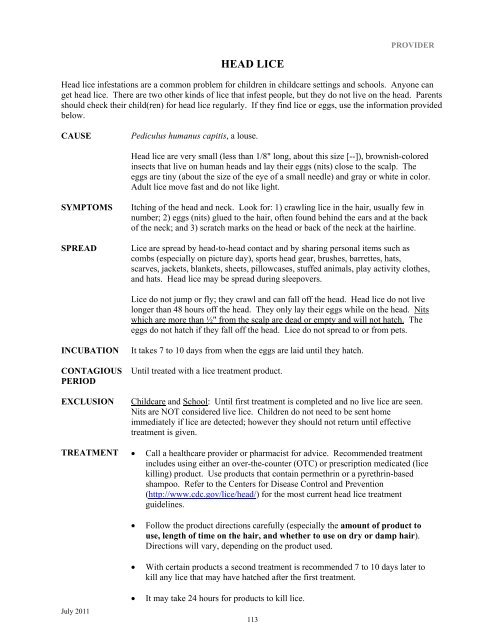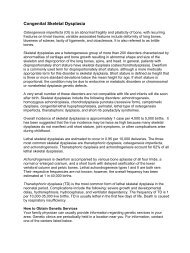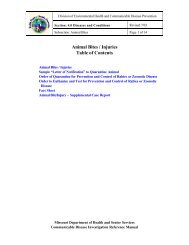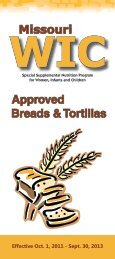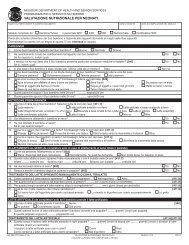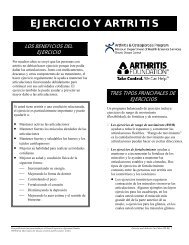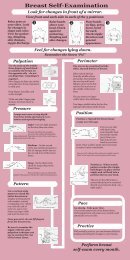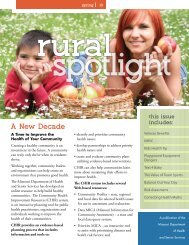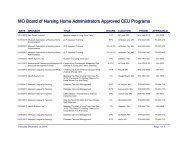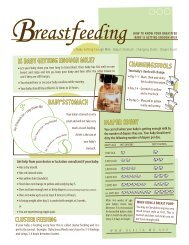Prevention and Control of Communicable Diseases - Missouri ...
Prevention and Control of Communicable Diseases - Missouri ...
Prevention and Control of Communicable Diseases - Missouri ...
Create successful ePaper yourself
Turn your PDF publications into a flip-book with our unique Google optimized e-Paper software.
July 2011<br />
HEAD LICE<br />
113<br />
PROVIDER<br />
Head lice infestations are a common problem for children in childcare settings <strong>and</strong> schools. Anyone can<br />
get head lice. There are two other kinds <strong>of</strong> lice that infest people, but they do not live on the head. Parents<br />
should check their child(ren) for head lice regularly. If they find lice or eggs, use the information provided<br />
below.<br />
CAUSE Pediculus humanus capitis, a louse.<br />
Head lice are very small (less than 1/8" long, about this size [--]), brownish-colored<br />
insects that live on human heads <strong>and</strong> lay their eggs (nits) close to the scalp. The<br />
eggs are tiny (about the size <strong>of</strong> the eye <strong>of</strong> a small needle) <strong>and</strong> gray or white in color.<br />
Adult lice move fast <strong>and</strong> do not like light.<br />
SYMPTOMS Itching <strong>of</strong> the head <strong>and</strong> neck. Look for: 1) crawling lice in the hair, usually few in<br />
number; 2) eggs (nits) glued to the hair, <strong>of</strong>ten found behind the ears <strong>and</strong> at the back<br />
<strong>of</strong> the neck; <strong>and</strong> 3) scratch marks on the head or back <strong>of</strong> the neck at the hairline.<br />
SPREAD Lice are spread by head-to-head contact <strong>and</strong> by sharing personal items such as<br />
combs (especially on picture day), sports head gear, brushes, barrettes, hats,<br />
scarves, jackets, blankets, sheets, pillowcases, stuffed animals, play activity clothes,<br />
<strong>and</strong> hats. Head lice may be spread during sleepovers.<br />
Lice do not jump or fly; they crawl <strong>and</strong> can fall <strong>of</strong>f the head. Head lice do not live<br />
longer than 48 hours <strong>of</strong>f the head. They only lay their eggs while on the head. Nits<br />
which are more than ½" from the scalp are dead or empty <strong>and</strong> will not hatch. The<br />
eggs do not hatch if they fall <strong>of</strong>f the head. Lice do not spread to or from pets.<br />
INCUBATION It takes 7 to 10 days from when the eggs are laid until they hatch.<br />
CONTAGIOUS<br />
PERIOD<br />
Until treated with a lice treatment product.<br />
EXCLUSION Childcare <strong>and</strong> School: Until first treatment is completed <strong>and</strong> no live lice are seen.<br />
Nits are NOT considered live lice. Children do not need to be sent home<br />
immediately if lice are detected; however they should not return until effective<br />
treatment is given.<br />
TREATMENT � Call a healthcare provider or pharmacist for advice. Recommended treatment<br />
includes using either an over-the-counter (OTC) or prescription medicated (lice<br />
killing) product. Use products that contain permethrin or a pyrethrin-based<br />
shampoo. Refer to the Centers for Disease <strong>Control</strong> <strong>and</strong> <strong>Prevention</strong><br />
(http://www.cdc.gov/lice/head/) for the most current head lice treatment<br />
guidelines.<br />
� Follow the product directions carefully (especially the amount <strong>of</strong> product to<br />
use, length <strong>of</strong> time on the hair, <strong>and</strong> whether to use on dry or damp hair).<br />
Directions will vary, depending on the product used.<br />
� With certain products a second treatment is recommended 7 to 10 days later to<br />
kill any lice that may have hatched after the first treatment.<br />
� It may take 24 hours for products to kill lice.


